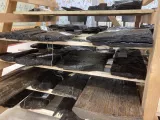Published: 24.05.2021
Sixteen months. For such a long time did the experts from the Faculty of Restoration keep a 7,000 years old well in sugar solution. They aimed to preserve the oldest wooden structure worldwide, found by archaeologists near Ostrov na Chrudimsku in 2018. They succeeded. Experts have just taken out the parts from special containers and proceeded to the second phase of the restoration.
The cellars of the Faculty of Restoration, University of Pardubice, in Litomyšl were the place where experts kept parts a well for over a year, placed in special containers with ordinary sugar solution. They preserved the parts of the well by one of the methods currently used to preserve water-saturated wood, where it is essential not only to strengthen the wood mass but also to prevent shrinkage of wood during drying.
The expected time of drying is 4–5 months. In the case of several selected parts of wells, the weight is measured at regular intervals to accurately determine the end of drying after the weight has stabilised.
In a sweet solution
“Having considered the available options and their advantages or limitations, we chose the method of preservation with a concentrated sucrose solution. First, we removed the soil residues carefully and applied biocidal agent from the wooden parts, which we subsequently immersed in a preservative solution of sucrose,” said Karol Bayer, the Vice-Dean for Research and an excellent scientist of the university.
Over the next few months, the restorers gradually increased the concentration of the sugar solution up to 55 per cent of its weight. The preservative solution also contained a biocide to protect the parts of the well and the preservative solution itself from being attacked by microorganisms. The total impregnation time lasted 16 months. The wood experts determined it based on their previous experience, thereby guaranteeing sufficient saturation of the thickest parts of the well with the preservative solution in the entire volume.
From wet to dry
At the end of 2020, the experts completed the impregnation, removed the individual parts of the well from the concentrated sucrose solution, and stored them to dry out under stable and controlled climatic conditions. “During the drying process, we monitor the parts of the well for any undesirable changes, such as shape deformations or attacks by microorganisms,” describes Karol Bayer, the Vice-Dean of the faculty.
The restoration of the well itself is carried out by the restorers of the University of Pardubice in cooperation with students Marek Laška, Vít Šaffr, and faculty employee Jiří Hubinka. Among those who took part in the restoration of the prehistoric well were also the specialists in wood preservation – Klára Drábková and Irena Kučerová from the Department of Chemical Technology of Monument Conservation, University of Chemistry and Technology in Prague.
The prehistoric oak well dates back to the Neolithic. According to the results of a dendrochronological survey carried out by the employees of the Department of Wood Science and Technology, the Faculty of Forestry and Wood Technology, Mendel University in Brno, it was made in 5259 or 5258 BC. During a survey carried out by the Olomouc Archaeological Centre under the leadership of Assoc. Prof. Jaroslav Peška, the archaeologists discovered another well in the Pardubice region, this time made of fir wood, which is also being cared for by the experts of the Faculty of Restoration, University of Pardubice.


